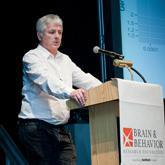Important New Research on Schizophrenia Genetics Provides Strongest Evidence to Date of Problems at the Brain’s Synapses
Important New Research on Schizophrenia Genetics Provides Strongest Evidence to Date of Problems at the Brain’s Synapses

With the publication of two papers in the journal Nature, hundreds of scientists, including dozens who have received BBRF grants or who are BBRF Scientific Council members, have provided the most comprehensive picture to date of how variations in the human genome affect schizophrenia risk.
The new papers shed intriguing light on what has always been the most elusive and potentially useful aspect of schizophrenia genetics: moving from an identification of “risk locations” in the genome to actual biological processes affected by mutations in these regions that specifically contribute to causation of the illness.
The two papers are based on the coordinating work of two international consortia. One, the Psychiatric Genomics Consortium (PGC), studies commonly occurring genetic variants in the broad population that are statistically associated with small increments of heightened risk for schizophrenia. The other group, called Schizophrenia Exome Meta-Analysis (SCHEMA), focuses on rare variations in the genome associated with increased schizophrenia risk.
“Psychiatric disorders have been a black box for a long time,” said Tarjinder Singh, Ph.D., of Columbia University. But “genomic technologies, sequencing infrastructure, and computational tools” used in the two studies “have advanced dramatically,” he noted, making new insights possible. Dr. Singh, a 2019 BBRF Young Investigator, is a co-author of the PGC paper and co-corresponding author of the SCHEMA paper.
Over the last decade, the PGC has painstakingly assembled a cohort consisting of over 320,000 individuals, of whom 76,755 are diagnosed with schizophrenia and over 243,000, serving as controls, do not have the illness. The larger the size of the cohort, the more statistical power the analysis can have. The PGC performs what are called GWAS (genome-wide association studies)—looking for locations (“loci”) in the genome where variations in the human DNA sequence are associated with some amount of increased risk, in this case, for schizophrenia. The new paper by the PGC brings the number of such “risk loci” to 287, which the team found were concentrated in genes expressed in neurons of the central nervous system but not in other tissues or cell types. Senior authors of the PGC paper included Michael C. O’Donovan, M.D., Ph.D., Stephan Ripke, M.D., Ph.D., and Patrick Sullivan, M.D., FRANZCP. Dr. O’Donovan is the 2012 BBRF Leiber Prize winner. Dr. Ripke is a 2015 BBRF Young Investigator and winner of the BBRF Baer Prize in 2014. Dr. Sullivan is the 2014 BBRF Lieber Prize winner.
A common disease-linked variant occurs in at least 1 in 100 people. Most of the schizophrenia-associated common variants uncovered so far have frequencies higher than 1%; some, in fact, are carried by 95% or more of the population, notes Dr. O’Donovan. Every person alive therefore likely carries multiple common risk variants, he explains, although in most individuals, the total risk for schizophrenia is about 1%. It remains unknown how combinations of particular variants may substantially increase risk in certain individuals or how they might interact with other contributing causal factors, including environmental ones, to cause the illness.
Much of the interest in the paper published by the SCHEMA group is that it gives a plausible view of how specific gene variations may be implicated in biological processes that help cause schizophrenia. The analysis is based on identification of a small number of genes—10—and variations in them which occur rarely (roughly, in 1 in 10,000 human beings). Those who carry these variations have a greatly increased risk of developing schizophrenia, ranging from several fold to as much as 50-fold (at which point, there is about a 50% chance a carrier will develop schizophrenia).
SCHEMA’s dataset substantially overlaps with the PGC sample, consisting of 24,248 people diagnosed with schizophrenia and over 97,000 controls without schizophrenia. Unlike GWAS studies, which look at the entire genome, the SCHEMA dataset reflects analysis of only the exome. The exome is the small subset of the full genome—about 2% of it—that consists of genes that encode the myriad proteins of the human body. (Ninety-eight percent of the genome is not involved in encoding proteins; much of it is thought to regulate how much, when, and where specific proteins are produced).
Many of the “risk loci” identified in GWAS studies and associated with some amount of heightened schizophrenia risk are located in the “non-[protein] coding” portion of the genome, and its biological significance remains a subject of intense study. In the new PGC paper, prior clues linking some common risk locations in schizophrenia with problems at the synapse—the gaps across which neurons in the brain communicate—have been seen once again, adding to the credibility of this analysis.
The SCHEMA study also found links with the synapse. All of the 10 genes identified in the SCHEMA study are not only protein encoders; researchers were able to determine specific types of mutations in these genes which not only can perturb protein production but impair their function.
One gene identified in the SCHEMA analysis (and also seen in the PGC’s survey of common variants) is called GRIN2A. It encodes a part of the cellular receptor for the neurotransmitter glutamate. One theory of schizophrenia pathology is that synaptic communication is disrupted, perhaps in neurons sensitive to excitatory glutamate signals. The SCHEMA discovery of rare mutations in GRIN2A and in another gene called GRIA3 are solid genetic evidence of this mechanism in schizophrenia causation and/or dysfunction. Intriguingly, GRIN2A activity in the brain peaks during adolescence, which is the time, typically, when people who develop schizophrenia begin to have symptoms.
To the extent that there is overlap in the small number of genes so far identified by the SCHEMA group and the common variants identified by the PGC, there was also “some amount of overlap in the stories that the common and rare variant associations were telling us,” according to Benjamin Neale, Ph.D., of the Stanley Center.




